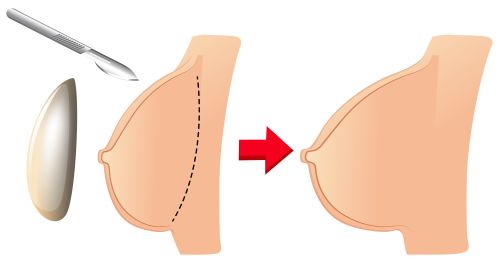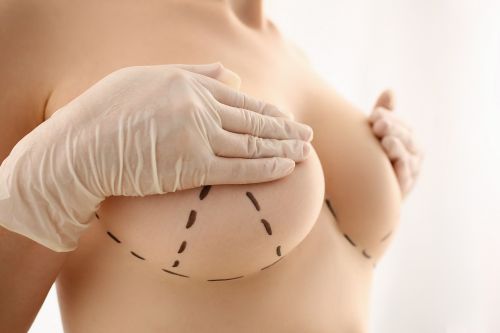Breast augmentation is a surgical procedure performed to increase the size of women's breasts. Typically, implants filled with silicone or saline are used. It is preferred for aesthetic concerns, asymmetric breast structure, or loss of volume. Breast augmentation surgery is performed under general anesthesia. The recovery process takes a few weeks. As a result, patients have fuller and aesthetically pleasing breasts. This procedure varies according to personal preferences.
In Which Situations is Breast Augmentation Surgery Performed?
 It is preferred in cases of dissatisfaction with the small size of the breasts. It is applied to balance breasts of different sizes. It is done to provide an aesthetic appearance in cases of loss of breast volume after pregnancy or breastfeeding. It is preferred to achieve a youthful appearance in cases of sagging or volume loss of the breasts over time. Breast augmentation surgery is also used to correct deformities resulting from breast cancer treatment. It can be done to provide better balance and appearance with certain sports. It is applied to increase the self-confidence of individuals experiencing psychological discomfort with their breast size.
It is preferred in cases of dissatisfaction with the small size of the breasts. It is applied to balance breasts of different sizes. It is done to provide an aesthetic appearance in cases of loss of breast volume after pregnancy or breastfeeding. It is preferred to achieve a youthful appearance in cases of sagging or volume loss of the breasts over time. Breast augmentation surgery is also used to correct deformities resulting from breast cancer treatment. It can be done to provide better balance and appearance with certain sports. It is applied to increase the self-confidence of individuals experiencing psychological discomfort with their breast size.
How is Breast Augmentation Surgery Performed?
 Before the surgery, patients have a detailed consultation with the surgeon. In this meeting, information is obtained about the patient's expectations, health status, and the appropriate type of implant. In addition, patients are informed about the possible risks and outcomes of the surgery. Breast augmentation surgery can be performed under general anesthesia or sedation. This is done to ensure the patient's comfort and prevent pain. There are various incision methods for this procedure. Inframammary (under the fold) is an incision made in the natural fold under the breast. Periareolar is an incision made around the nipple. Transaxillary is an incision made from the armpit. After making the incision, the surgeon places the implant behind the breast or under the muscle. The placement area varies depending on the patient's body structure and preference. After placing the implant, the surgeon closes the incisions with sutures. Usually, aesthetic sutures are used to minimize the appearance of scars. After the operation, patients are usually kept under observation for a while. The recovery process can vary from person to person. However, they can usually return to normal activities within 1-2 weeks. The surgeon provides post-operative care instructions. The results of breast augmentation surgery usually start to be seen immediately, but it may take a few months for the final results to be visible. The shape and placement of the implants settle over time and gain a natural appearance.
Before the surgery, patients have a detailed consultation with the surgeon. In this meeting, information is obtained about the patient's expectations, health status, and the appropriate type of implant. In addition, patients are informed about the possible risks and outcomes of the surgery. Breast augmentation surgery can be performed under general anesthesia or sedation. This is done to ensure the patient's comfort and prevent pain. There are various incision methods for this procedure. Inframammary (under the fold) is an incision made in the natural fold under the breast. Periareolar is an incision made around the nipple. Transaxillary is an incision made from the armpit. After making the incision, the surgeon places the implant behind the breast or under the muscle. The placement area varies depending on the patient's body structure and preference. After placing the implant, the surgeon closes the incisions with sutures. Usually, aesthetic sutures are used to minimize the appearance of scars. After the operation, patients are usually kept under observation for a while. The recovery process can vary from person to person. However, they can usually return to normal activities within 1-2 weeks. The surgeon provides post-operative care instructions. The results of breast augmentation surgery usually start to be seen immediately, but it may take a few months for the final results to be visible. The shape and placement of the implants settle over time and gain a natural appearance.
Precautions to be Taken After Breast Augmentation Surgery
 It is very important to rest in the first few days after the operation. Get enough sleep to help your body heal. Start moving immediately after the surgery, but avoid heavy lifting and strenuous activities. Change your bandages according to your doctor's recommendations. It is important that the bandage stays in place in the first few days. Keep your stitches clean and dry. Follow the stitch care instructions given by your doctor. Use the painkillers recommended by your doctor. Do not forget to take your painkillers when needed. Avoid intense exercise and heavy activities for at least 4-6 weeks after breast augmentation surgery. You can increase your blood circulation by taking light walks. Consult your doctor before starting to exercise. Be careful not to start sports that affect the chest area (swimming, running) early. Establish a healthy and balanced diet during the recovery process. Drinking plenty of water and consuming vitamin-rich foods is important. Schedule regular check-up appointments with your doctor after the surgery. These appointments are important to monitor your recovery process. You may experience emotional changes after the surgery. Seek professional support if necessary. Wear the supportive bra recommended by your doctor. This supports your breasts and contributes to the healing process. By following these recommendations after breast augmentation surgery, you can speed up your recovery process. You can also minimize possible complications. Remember that each individual's recovery process may be different. Therefore, always prioritize your doctor's instructions.
It is very important to rest in the first few days after the operation. Get enough sleep to help your body heal. Start moving immediately after the surgery, but avoid heavy lifting and strenuous activities. Change your bandages according to your doctor's recommendations. It is important that the bandage stays in place in the first few days. Keep your stitches clean and dry. Follow the stitch care instructions given by your doctor. Use the painkillers recommended by your doctor. Do not forget to take your painkillers when needed. Avoid intense exercise and heavy activities for at least 4-6 weeks after breast augmentation surgery. You can increase your blood circulation by taking light walks. Consult your doctor before starting to exercise. Be careful not to start sports that affect the chest area (swimming, running) early. Establish a healthy and balanced diet during the recovery process. Drinking plenty of water and consuming vitamin-rich foods is important. Schedule regular check-up appointments with your doctor after the surgery. These appointments are important to monitor your recovery process. You may experience emotional changes after the surgery. Seek professional support if necessary. Wear the supportive bra recommended by your doctor. This supports your breasts and contributes to the healing process. By following these recommendations after breast augmentation surgery, you can speed up your recovery process. You can also minimize possible complications. Remember that each individual's recovery process may be different. Therefore, always prioritize your doctor's instructions.


